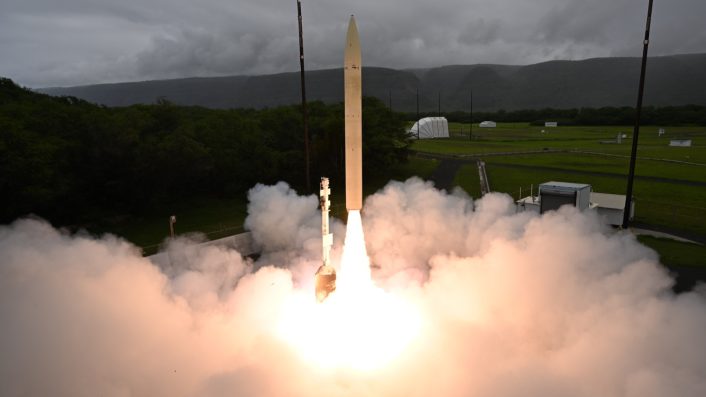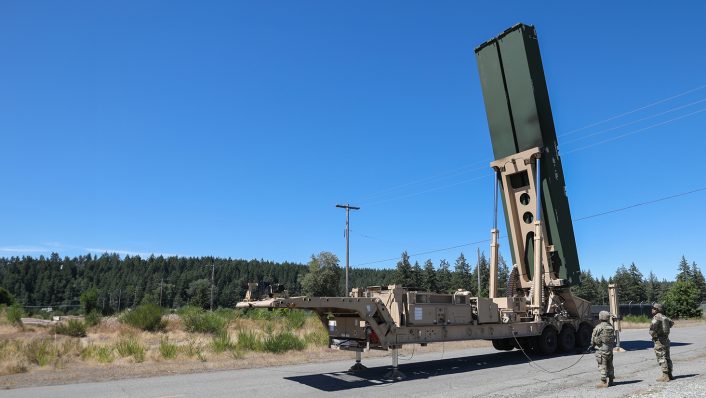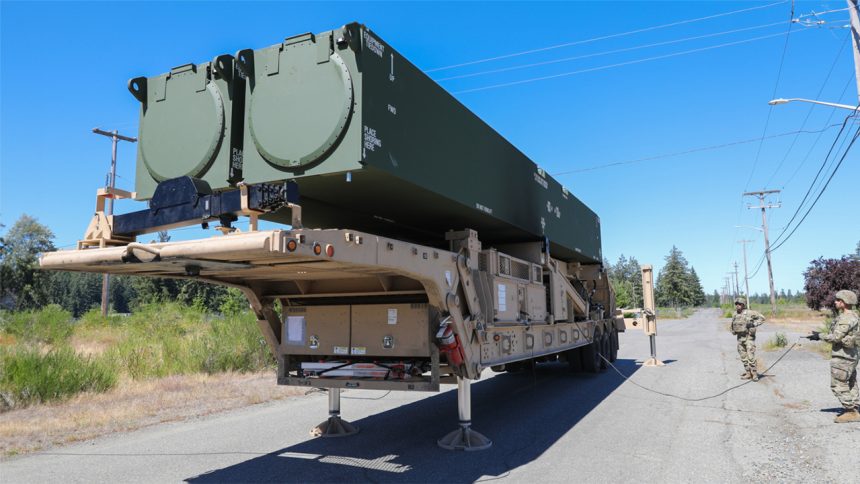The service successfully employed its Multi-Domain Task Force force package for over 72 hours, showcasing the LRHW’s ‘digital kill chain’.
The US Army revealed last week that the 1st MDTF (Multi-Domain Task Force) included for the first time the LRHW (Long-Range Hypersonic Weapon) in the bi-annual Exercise Resolute Hunter at Joint Base Lewis-McChord, Washington, from Jun. 25 to 27, 2024. This was a week before the White House announced on July 10 the deployment to Germany by 2026 of SM-6 (Standard Missile-6) and Tomahawk LACMs, as part of the MRC Typhon system, as well as the PrSM (Precision Strike Missile) and the LRHW (Long-Range Hypersonic Weapon).
“The U.S. Army’s Long-Range Hypersonic Weapon (LRHW) Battery, part of the 1st Multi-Domain Task Force (MDTF), made history by participating in Exercise Resolute Hunter 24-2, a joint/combined exercise on the base from June 25-27, 2024,” said a statement. The drill marked a significant milestone, as it was the “first time the Army’s hypersonic capability was integrated into the bi-annual joint training exercise.”
US Army’s Long-Range Hypersonic Weapons Battery Debuts in Resolute Hunter Exercise.
Via DVIDS:
” The U.S. Army’s Long-Range Hypersonic Weapon (LRHW) Battery, part of the 1st Multi-Domain Task Force (MDTF), made history by participating in Exercise Resolute Hunter 24-2, a… pic.twitter.com/iEDSLU7eBc
— 𝔗𝔥𝔢 𝔇𝔢𝔞𝔡 𝔇𝔦𝔰𝔱𝔯𝔦𝔠𝔱 🇬🇪🇺🇦🇺🇲🇬🇷 (@TheDeadDistrict) July 19, 2024
MDTFs, mid and long-range fires
The four missile systems form the core long and medium-range fires component of the MDTFs, which the U.S. Army plans to deploy worldwide in various flashpoints. According to Defense News, the Army established the 2nd MDTF in Europe in 2021. Two other MDTFs are based in the Indo-Pacific theater with plans to set up two more for a total of five MDTFs.
Three MDTFs will be focused on Pacific operations, one in Europe and one will be based at Fort Liberty, North Carolina, all capable of rapid deployment wherever needed. The 2st MDTF, meanwhile, successfully deployed the MRC in the northern part of Philippines’s Luzon province on Apr. 11, 2024.
The LRHW, also known as Dark Eagle, and the PrSM can reach ranges of 2,776 km and 482 km, respectively. The SM-6 air defense missile, which has a secondary anti-ship capability, and the Tomahawk can touch distances of over 1,500 km.

Training for joint strikes
Resolute Hunter 24-2 is the DoD’s only dedicated BMC2ISR (Battle Management, Command and Control, Intelligence, Surveillance, and Reconnaissance) exercise. “This year’s event brought together three participating nations and four joint services for a three-week training exercise,” the statement added. The countries are not identified, however they can be assumed to be from either European NATO member nations, or some of the U.S. Allies from the Indo-Pacific region.
The statement quoted Col. Charles Kean, commander of 1MDTF, saying the “scenarios provide invaluable sets and repetitions that build upon and reinforce the steadfast integration of MDTF capabilities in the broader Partnered Joint All-Domain construct.”
The exercise demonstrated the battery’s ability to integrate with higher joint echelons and sustain operations over an extended period. Bravo Battery, 5th Battalion, 3rd Field Artillery (Long Range Fires Battalion), 1MDTF, successfully employed its force package for over 72 hours, showcasing the LRHW “digital kill chain” in collaboration with joint partners and providing real-time situational awareness to the joint command post.
It appears there was no live-fire involved, with possibly only electronic launches being conducted. Bravo Battery commander Capt. Jennifer Lee said the exercise “demonstrated the critical role of landpower and the Army’s indispensable contribution to joint operations.”

US Army’s LRHW
The Army’s long-range hypersonic weapon development has been a long-term effort, with soldiers contributing to the prototyping process since 2019. After receiving the initial hardware delivery in Mar. 2021, the unit initiated New Equipment Training (NET) in Sep. 2021, which consisted of four three-week iterations.
The fielding process was completed by the end of fiscal year 2023, enabling soldiers to train on the equipment, create doctrine, and develop new tactics, techniques, and procedures. In Feb. 2023, the unit deployed the capability more than 4.828 km to Cape Canaveral, Florida, in its “longest recorded overland movement to date.” Part of Exercise Thunderbolt Strike, it demonstrated the Army’s ability to rapidly deploy the hypersonic capability. Since then, the unit has participated in several other named and joint exercises, with Resolute Hunter being the latest.
The 5th Battalion, 3rd Field Artillery Regiment received the first LRHW at JB Lewis-McChord in early-2021. Scheduled tests were however canceled in Sep. 2023 owing to “problems” being discovered. Prior to that, a joint test by the Army and the U.S. Navy slated in March of that year was also canceled.
“The U.S. Army awarded Lockheed Martin (LM) a $756 million contract … Under the new contract, LM will provide additional Long-Range Hypersonic Weapon (LRHW) battery equipment, systems & software engineering support, and logistics solutions to the Army.”
https://t.co/oGEXpCQj7k pic.twitter.com/HvVXZflAUO
— Guy Plopsky (@GuyPlopsky) May 17, 2024
Finally, the DoD announced on Jun. 28, 2024, the two services having conducted an “end-to-end flight test” of the hypersonic missile from the Pacific Missile Range in Kauai, Hawaii. “The test provided data on the end-to-end performance of the Conventional Prompt Strike and Long Range Hypersonic Weapon All Up Round” and “marked a step forward” for the programs.
The US Army and the USN are jointly pursuing the weapon as it shares what is described as the C-HGB (Common-Hypersonic Glide Body). The C-HGB is made up of the weapon’s warhead, guidance system, cabling and thermal protection shield. The USN’s version of the hypersonic weapon is called the CPS (Conventional Prompt Strike).
The challenge before the service is to not rush into production without having conducted extensive testing and data from the fires. This is to validate the design and finalize the engineering configuration and avoid tedious tweaks to the hardware in the middle or after the serial production stage.
#US Army displays model of new hypersonic weapon
The Long Range Hypersonic Weapon (LRHW) – The Army’s LRHW will introduce a new class of ultrafast, maneuverable, long-range missiles that will launch from mobile ground platforms👍https://t.co/nByyavEyjY pic.twitter.com/qooDkY3psQ
— Indo-Pacific News – Geo-Politics & Defense (@IndoPac_Info) February 28, 2020
‘All Domain’ MDTFs
The statement revealed the CONOPs (Concept of Operations) behind the MDTF and its long-range missile fires capabilities, which comprises arming the formations with sensor and shooter capabilities across multiple domains, including air, land, sea and cyberspace. Even long-range surveillance drones are a part of the mix for target acquisition and reconnaissance.
This is how the 1MDTF’s assignment to the Indo-Pacific in being described: “As a theater-level unit and Joint Force enabler, assigned to the Indo-Pacific, the 1MDTF plays a vital role in synchronizing long-range precision fires layered with long-range precision effects to create multiple dilemmas and neutralize adversary A2AD (anti-access and area denial) networks. The 1MDTF’s proven innovation, agility, and lethality have led the Army to direct five full MDTFs in strategically significant locations worldwide.”









